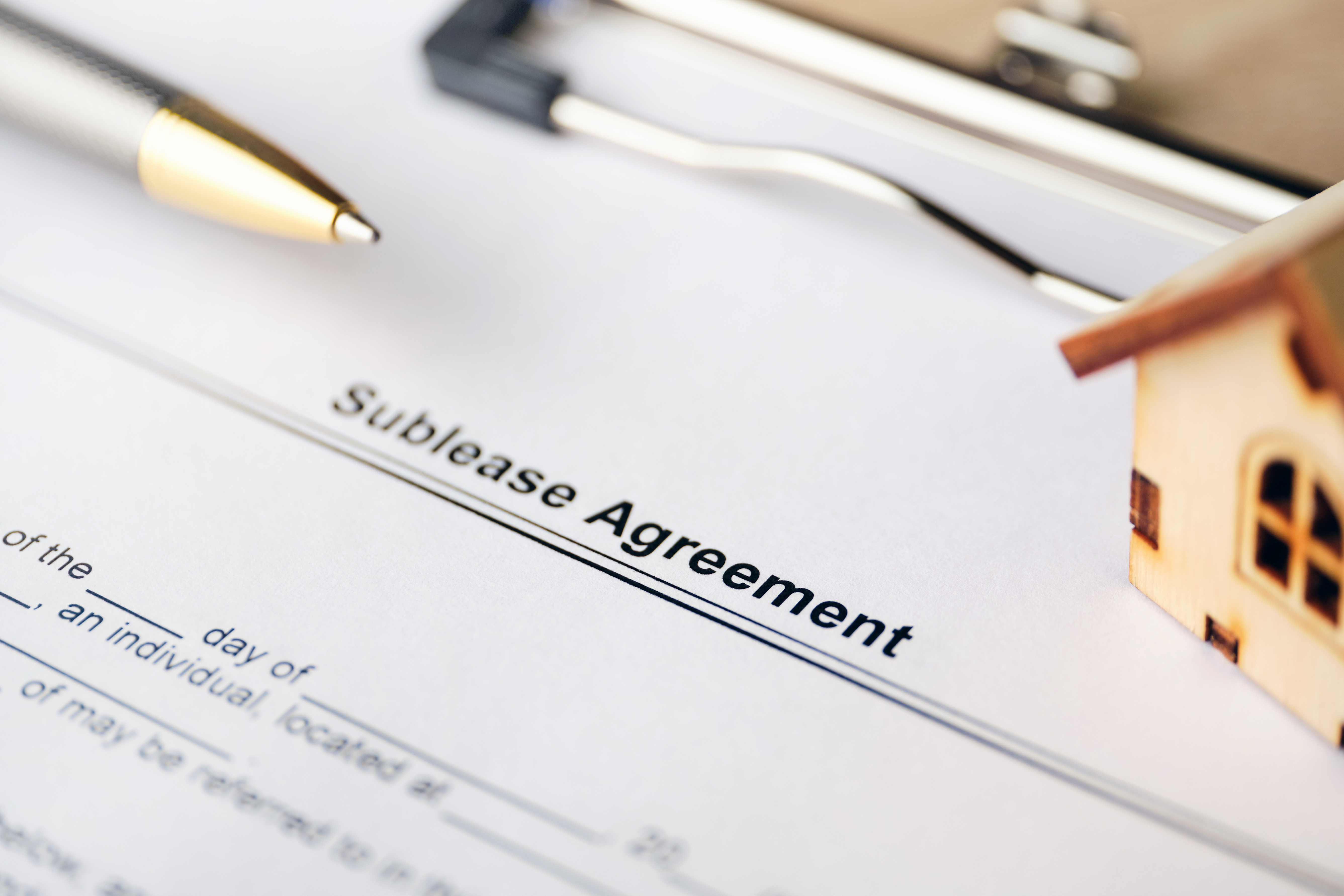
Subletting an Apartment - What Renters Need to Know
There are many reasons renters may want to sublet (aka sublease) their apartment. Whether you’ve landed a new job requiring you to relocate or you're struggling to make ends meet, subletting can help you pay rent.
However, before you decide to sublet your apartment, there's a lot to consider, including everything from understanding local and state sublease laws to confirming that the terms of your original lease allow it. That’s right, not all rental agreements permit subletting. More on that later. But, first things first, let’s define subleasing.
What is subletting / subleasing?
Used interchangeably and meaning the same thing, subletting / subleasing is when a tenant named on a rental agreement rents a room or entire apartment to another person during the original lease period.
Renters can sublet their spaces short-term, such as for a month, or they can sublet for nearly the whole length of their lease. When subletting an apartment, renters may find a new tenant to take over the entire square footage of the rental or just one room in the unit.
A sublease doesn’t transfer the original lease or its responsibilities to a new tenant. It merely allows someone else to live on the property. The original tenant on the rental agreement (the sublessor) is still the contracting party, and the landlord may continue to hold this tenant to all terms of the lease. If you are interested in being taken off the original lease, then you'd have to find another tenant interested in an apartment lease takeover instead.
How do I sublet my apartment?
If you've decided that you want to sublet your apartment, there are a few crucial steps to take beforehand to make sure it doesn't go south. Since subletting can be risky, you'll want to make sure that you and your landlord are protected and that you pick the right tenant.
1. Get your roommates’ and landlord’s permission.
Before you’re able to sublet your apartment or your bedroom, you’ll need to get it cleared with a few people. If you have roommates, you’ll want to talk through your plans with them to make sure they are comfortable with a new tenant moving in. They may even want to be a part of the screening process to ensure that they will be compatible with any prospective tenants.
You’ll also want to check your lease agreement to see if it contains language about subletting. If it doesn’t, talk with your landlord about drawing up an addendum to a lease agreement to allow for a sublease. Because the tenant and subtenant relationship is removed from the original lease, subletting is not advised without landlord approval. When you sublet an apartment to a subtenant (sublessee), that new renter will want permission from the landlord to use all spaces noted on the original lease (private and common) as the original contracting tenant would. Remember that subletting may not get your landlord’s consent.
2. Screen potential subletters by checking their credit score, calling references, and more.
Tenants who need to convince a landlord to allow a subtenant may want to conduct interviews with a new renter first and perform a background check on viable candidates. There are also services available that can help renters run credit reports and other verifications on subtenants. Being able to vouch for a sublessee could help persuade a landlord to allow subletting. Renters with original lease agreements that permit subtenants may not have to convince a landlord of a new tenant’s suitability. However, you should still do your due diligence and request a credit and background check as well as references for any potential subtenant. After all, your name remains on the original lease and you don’t want to be slammed with late fees if your sublessee stops paying.
Keep in mind that some landlords will charge the original tenant a fee to sublease. However, many state and local laws limit or prohibit landlord-imposed fees for subleasing.
3. Draw up a subletting agreement and get it signed by all parties.
Tenants who want to sublet their apartments would be wise to draw up a subletting agreement for the new tenant to sign. This helps ensure the sublessee will take care of the property and pay all rents and fees to the sublessor, who is still bound to the original lease terms in the rental agreement that they signed with the landlord. Sublease agreements can also include instructions for mailing monthly rent payments. If you are only subleasing for a short period of time, the agreement should also include the start and end date of the new tenancy. There are templates available online that you can use as a starting off point.
If you’re considering subletting your apartment, think about whether or not you want to leave any furniture or personal belongings for the new tenant to use. If so, make sure you note these items in your sublease agreement.
Sublessors may want to ask for a security deposit from subtenants. However, some state and local laws restrict security deposits, hence the need to do your research before subleasing.
4. Before you move out, do a walkthrough of the unit and document its condition.
If your landlord approves subletting and you’ve found someone perfect to sign a sublease agreement, having the new tenant move in is the next step. Many renters require subtenants to complete a rental unit inspection checklist upon move in to document the property’s condition. These checklists sometimes have space to document the property’s move-out condition, too. When added as addendums to sublease agreements, rental inspection checklists can help a sublessor hold a sublessee liable for damages caused during the sublet period.
6 Questions About Subletting
1. Is subletting legal?
Subleasing’s legality depends on your state and local laws, as well as the terms of your lease agreement. When considering subletting your apartment, you can learn a lot from a quick internet search, but consulting a lawyer and your property manager is advised.
2. Is subleasing safe?
Financially, subletting comes with some risks. If your subletter decides not to pay rent or damages your apartment, you’re legally bound by the landlord to resolve these problems. That’s why you need to do your homework on any potential sublessee before entrusting your place to them.
3. Who pays the utilities?
You can negotiate utilities with your subtenant, but remember that some original lease agreements may contain language on how the landlord collects utilities and which services are available. Check with your landlord for guidance before you write utilities into your sublease agreement.
4. Does my renters insurance cover subtenants?
Renters who want to sublet their apartment should check with their insurance companies to see if their renters insurance policy covers subtenants. If not, sublessees may need to obtain their own insurance to comply with the original lease agreement terms.
5. Can a subletter be evicted?
If a subletter violates the terms of the lease agreement, eviction is a possibility. A sublessor or landlord needs to have a valid reason for evicting a subletter, but it is an option if they stop paying rent, disturbing other roommates, or otherwise damaging or not following the rules of the rental unit. If a subletter is not following the rules of your rental agreement and you are struggling to evict them, consider seeking legal advice.
6. Where can I find a sublet?
Often times, when tenants are looking to sublet their apartment, they look for prospective tenants through informal channels like Facebook Marketplace, Craigslist, and social media groups. For example, if you are looking to find a sublet in a city like New York, try going on Facebook and searching the groups page for “New York subletting.”
The Bottom Line
Whether you call it subletting or subleasing, the meaning is one and the same, and it may very well be a viable option for you. But, it also may not be within your legal rights. Before subletting your place, you'll need to confirm doing so is on the up and up by consulting state and local subleasing laws, reviewing your rental agreement, checking with your landlord, verifying a subletter’s references, and drawing up a subleasing agreement.
Top cities
Atlanta Apartments
1,595 apartments starting at $700/month
Austin Apartments
5,074 apartments starting at $500/month
Baltimore Apartments
1,305 apartments starting at $475/month
Boston Apartments
5,622 apartments starting at $1,050/month
Charlotte Apartments
2,837 apartments starting at $560/month
Chicago Apartments
6,256 apartments starting at $638/month
Dallas Apartments
5,511 apartments starting at $595/month
Fort Worth Apartments
2,626 apartments starting at $500/month
Houston Apartments
5,239 apartments starting at $618/month
Las Vegas Apartments
1,067 apartments starting at $650/month
Los Angeles Apartments
11,096 apartments starting at $700/month
Miami Apartments
462 apartments starting at $1,200/month
Milwaukee Apartments
1,180 apartments starting at $545/month
New York Apartments
5,073 apartments starting at $1,000/month
Oakland Apartments
788 apartments starting at $850/month
Orlando Apartments
853 apartments starting at $940/month
Philadelphia Apartments
3,084 apartments starting at $500/month
Phoenix Apartments
4,126 apartments starting at $600/month
Pittsburgh Apartments
753 apartments starting at $450/month
Portland Apartments
2,124 apartments starting at $750/month
Raleigh Apartments
1,229 apartments starting at $550/month
San Antonio Apartments
3,479 apartments starting at $574/month
San Diego Apartments
2,866 apartments starting at $650/month
San Francisco Apartments
496 apartments starting at $830/month
San Jose Apartments
431 apartments starting at $1,100/month
Seattle Apartments
3,096 apartments starting at $650/month
Tampa Apartments
807 apartments starting at $812/month
Washington DC Apartments
2,212 apartments starting at $910/month


